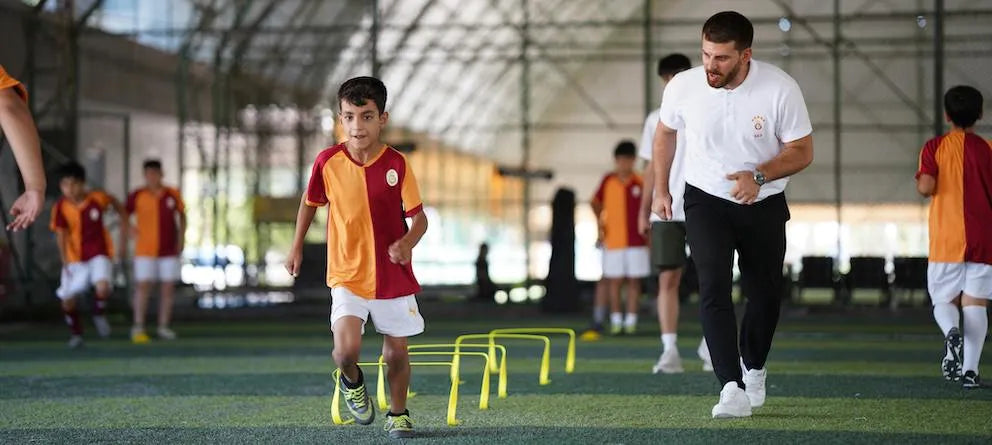The cornerstone of elite soccer performance is conditioning. By increasing your speed, stamina, agility, and explosiveness, the right training can help you play longer and recover in less time between plays. Here are seven proven soccer conditioning exercises to enhance your athletic ability and performance.
Drill #1: Sprint Intervals

One of the best methods for simulating in-game bursts of speed is to use sprint intervals. By simulating the stop-and-go rhythm of soccer, these brief, intense, energetic sprints alternating with recovery intervals enhance anaerobic and aerobic capacity. This exercise gradually improves your capacity to sustain extended, high-intensity efforts throughout matches without getting tired.
What You Need
- Open field or track
- Stopwatch or timer
Instructions
- Warm up with a light jog and dynamic stretches for 5 minutes.
- Sprint at maximum effort for 20 - 30 seconds.
- Walk or jog lightly for 60 - 90 seconds to recover.
- Repeat for 8 - 10 rounds.
- Cool down with easy jogging and stretching.
Drill #2: Shuttle Runs

Shuttle runs are a great way to boost your agility and direction changes. During this drill, your body is forced to repeatedly accelerate, decelerate and push off, which are essential motions for defenders and midfielders. When performed regularly, shuttle runs improve reaction time and prepare your legs for the constant direction shifts associated with competitive play.
What You Need
- 4 - 6 soccer cones
- Stopwatch or timer
Instructions
- Set two soccer cones 20 yards apart.
- Start at the first cone and sprint to the second.
- Touch the ground at the cone, then sprint back.
- Repeat for 6 - 8 reps per set.
- Rest 60 seconds, then complete 3 - 4 sets.
Drill #3: Ladder Drills

Agility ladder drills improve coordination and foot speed. They boost control and balance, which are vital when defending or dribbling during matches. Ladder drills are also great for improving timing, rhythm, and body control under pressure, as they help you practice a variety of patterns that your body goes through during matches.
What You Need
- Agility ladder
- Flat surface
Instructions
- Lay the ladder flat on the ground.
- Begin with the “one foot in each box” pattern to warm up.
- Progress to “in-in-out-out” or lateral shuffles.
- Focus on quick, light steps - don’t stomp.
- Perform 4 - 6 variations for 30 - 45 seconds each.
Drill #4: Cone Dribbles

Cone dribbles blend technical skill and conditioning. When your body experiences fatigue because of the constant shifts in pace, direction, and ball control, your endurance increases, promoting better play during matches. Cone drills also help you develop the ability to stay composed when defenders apply pressure.
What You Need
- 6 - 10 cones
-
Soccer ball
Instructions
- Place cones in a straight line, 3 - 4 feet apart.
- Dribble through the cones using both feet.
- Keep the ball close and under control.
- Sprint back to the start after finishing.
- Repeat 6 - 8 times with brief rests in between.
Drill #5: Hill Sprints

Hill sprints stimulate your cardiovascular system while building leg strength and explosive power. As a result of the incline that forces your body to produce more force, you become quicker and more resilient on the field. When compared to flat sprints, they also decrease impact stress, which lowers the risk of injury while maintaining intensity.
What You Need
- Steep hill or incline
- Stopwatch or timer
Instructions
- Warm up with light jogging on flat ground.
- Sprint uphill at maximum effort for 10 - 15 seconds.
- Walk back down slowly for recovery.
- Perform 8 - 12 repetitions.
- Cool down with light jogging and stretching.
Drill #6: Box Jumps

Box jumps improve coordination, power, and explosiveness in the lower body. This plyometric exercise is ideal for increasing acceleration, recovery speed, and vertical leap. Fast-twitch muscle fibers, which are essential for rapid sprints and energy spikes during a game, are also greatly developed by it.
What You Need
-
Plyometric box or sturdy platform (18 - 30 inches high)
Instructions
- Stand in front of the box with feet shoulder-width apart.
- Bend your knees and swing your arms for momentum.
- Explosively jump onto the box, landing softly on both feet.
- Step back down carefully.
- Perform 3 sets of 10 - 12 jumps.
Drill #7: Plank Variations

Stability, balance, and injury prevention are crucial in games, and core strength is essential for all of them. Plank variations engage multiple muscle groups, helping soccer players maintain strong posture and explosive movements throughout the game. Additionally, a strong core protects your body from falls and heavy tackles and increases your kicking power.
What You Need
-
Exercise mat
Instructions
- Begin with a standard plank (forearms on the ground, body straight).
- Hold for 30 - 60 seconds.
- Add variations like side planks, plank with shoulder taps, or plank-to-push-up.
- Perform 3 - 4 variations, 30 - 45 seconds each.
- Rest for 30 seconds between variations.
Soccer Conditioning Drills FAQs
1. What is the 4 goal drill in soccer?
The 4 goal drill uses four small goals placed on each side of a square field. Teams compete to score in any goal, which develops vision, quick decision-making, fitness, and awareness under pressure.
2. How often should soccer players do conditioning?
Most players benefit from conditioning 3 - 4 times per week. This schedule balances fitness gains with proper recovery, ensuring players avoid over-training while building stamina, agility, and endurance.
3. What is the 2 mile test in soccer?
The 2-mile test measures aerobic fitness by timing how quickly a player can run two miles. Coaches often use it to assess endurance levels and track progress during preseason or training cycles.




